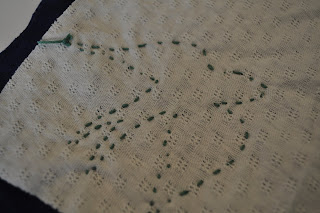I was recently asked to create some aprons for the wedding of my kid's PE teacher. He is a special kind of fella and really quite a gifted educator- more environmental education than jumping jacks- and he and his gal needed them to wear while they were handing out pie to all of the guests as they arrived. Love that! He wanted some swooping swallows and hearts on the chest and a pocket for whatever one might need it for. He also wanted a shawl with the same motif for his Granny. All together, 6 aprons and the shawl. I decided to use linen and keep them very raw and they really turned out lovely, if I do say so myself.
I thought I'd share how to make them so you can have one too.
What you'll need:
* an apron to copy
* a 1/2 yard of linen or other fabric of your choosing- anything will work
* another contrasting fabric- I used jersey cotton
* embroidery floss and needle
* contrasting thread for your machine
*an iron
Directions:
1) Fold the apron you will be tracing in half lengthwise and align the fold with your folded fabric. Use chalk to trace the shape of the apron and cut out.
2. Using chalk or disappearing ink, draw or stencil your shapes to be reverse appliqued onto the desired spot. I chose the breast of the apron.
3. Cut a piece of fabric large enough to back the chalked shapes. Pin to the back of the apron.
4. Thread an embroidery needle with a length of embroidery thread. I like to work with an arms length or so to keep it manageable. Tie a knot at the end and pull a stitch from the back of the apron to the front. Continue with a running stitch around the entire shape, ending with a knot to secure the thread on the backside of the apron.
.
5. To create the reverse applique, use a sharp tipped pair of scissors (embroidery scissors are perfect), and carefully cut the top layer of fabric away, about 1/16" from the embroidery thread. Cut excess backing fabric off.
6. To finish the apron, I chose not to hem or tape the edges, but thought I'd leave the edges raw. To minimize raveling (though I did want some), I sewed around the perimeter of the apron shape a few times, allowing my lines to meander a bit.
I sewed about 6 lines across the top like this.
7. Cut a 2" wide strip of linen fabric that is long enough to go around your neck and keep the apron top falling around the collar bones. It should still be able to slip over your head without being too loose. Next, fold the strip in half lengthwise and press with a hot iron. Sew a zig zag stitch along the open edges.
8. Pin the raw ends in place so the are on the front of the apron (again, show off those raw edges!). Stitch a box with one or two diagonals for strength/
9. The waist ties are also 2" wide strips. Make them long enough to reach from your sides and tie in a bow. This is really up to you and how much fabric you have. Use your scraps if you can. I left the edges raw, of course, and zig zagged along the edges before attaching to the apron.
10. To attach ties, pin them in place where the bib panel meets the straight apron bottom. This will be obvious. Use zig zag or straight stitches- whichever you prefer (I changed it up on different aprons because I am like that) to attach the ties to the front of the apron. Just be sure to backtack so they are nice and secure.
11. Want a pocket? Yes, they are good to have. I forgot to write down my dimensions, but I rememebr them being about 7.5" x 11". Again, do what you like. Before pinning it in place, run some stitched lines or zig zags along the open edge of the pocket. Or, even better, use a selvage edge that has a nice soft fuzzy fray that is won't ravel anymore.
Center the pocket in position, pin to secure, and zig zag along the raw edges to attach it to the apron front. Next run a straight stitch (I used a strong double straight stretch stitch) 1/8" in from the zig zag. That pocket isn't going anywhere.
Look, there is my use of the selvage along the top of the pocket. Isn't that nice?


































